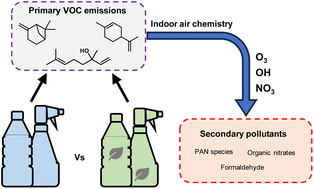Environ. Sci.: Processes Impacts, 2024, 26,436-450
DOI: 10.1039/D3EM00439B, Paper
DOI: 10.1039/D3EM00439B, Paper
 Open Access
Open Access This article is licensed under a Creative Commons Attribution 3.0 Unported Licence.
This article is licensed under a Creative Commons Attribution 3.0 Unported Licence.Ellen Harding-Smith, David R. Shaw, Marvin Shaw, Terry J. Dillon, Nicola Carslaw
Cleaning products emit a range of volatile organic compounds (VOCs), including some which are hazardous or can undergo chemical transformations to generate harmful secondary pollutants.
The content of this RSS Feed (c) The Royal Society of Chemistry
Cleaning products emit a range of volatile organic compounds (VOCs), including some which are hazardous or can undergo chemical transformations to generate harmful secondary pollutants.
The content of this RSS Feed (c) The Royal Society of Chemistry

